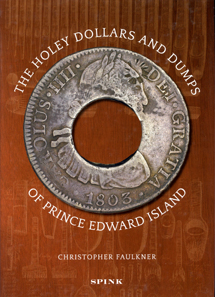by Ursula Kampmann
May 30, 2013 – Today we have difficulties to imagine what monetary problems many colonies had to face during their beginnings. The coins the government sent to organize the cash flow disappeared nearly immediately. In most cases it was used exclusively for purchasing goods from the motherland while the colonists, on the other hand, were required to give their products in exchange for imported goods. Cunning dealers benefitted from this plight gaining double: First when they sold the imported goods, then when selling the exchanged local products.
Of course the local administration made efforts of intervening. However, all coins shipped to the colonies disappeared in no time into dark channels. In 1811 they got an idea how to solve this problem in the Caribbean. In Dominica, St Vincent and Trinidad the first Holey Dollars were introduced. In 1813 this was imitated by the governor of a small colony on an island off the eastern coast of Canada that, since 1798, bore the name of Prince Edward Island. He created coins which would never run off abroad since their accepted face value in the country was much higher than the intrinsic value that counted outside. In order to achieve this 1,000 Spanish reales de a ocho worth five English shillings each were punched in the middle with a hollow punch. Although their weight was by that reduced decisively, on Prince Edward Island they kept their value of five shillings. The so-called Dump – the punched piece – was assessed the value of one shilling.
Christopher Faulkner, The Holey Dollars and Dumps of Prince Edward Island. Spink, London 2012. 382 p. colour images. Hardcover. 21,5 x 30,5cm. ISBN 978-1-907427-18-3.
Christopher Faulkner has dedicated a comprehensive monograph to these issues, the Holey Dollars and Dumps of Prince Edward Island. He describes in detail the history of the coins and their predecessors and reconstructs the method of production. He tells us how they became so economically successful that soon dealers started to make imitations of these popular coins. And of course one chapter deals with modern imitations aiming at collectors.
The author narrates the story using many original sources that speak of the twenty years of research he has invested. And the book is very worth reading, although a clearer arrangement by a more prudential use of spaces and font sizes – particularly with the chapter titles – would have been helpful to the reader.
The first part of the book is dedicated to the history, the second part to the objects – all known specimens of Holey Dollars and Dumps of Prince Edward Island. European collectors may not been accustomed to the American way of giving a name to each piece, generally according to its proprietor. The tireless author was able to find 79 Holey Dollars and 12 Dumps. First he gives a statistical analysis, then he lists all auction sales where these Prince Edward Island Holey Dollars were offered and all publications where illustrations of them are given.
The catalogue is arranged according to groups defined by mintmarks and dedicates at least a whole page to each specimen: an image in enlarged proportion, technical data, provenance and bibliographical mentions, a commentary and photo captions. A non specialist is astonished how much one can write about each piece. A focus is on the transmission history. Many collectors coins are named after are presented with photographs. An emormous labour is behind all these details which the author has gathered throughout the whole western world.
In other chapters Christopher Faulkner presents related issues. In appendices he offers official documents, private mentions and more recent texts. Another appendix lists all dealers, craftsmen, and officials of Charlottetown, the capital of Prince Edward Island, as far as they are traceable. Several indexes help to find one’s way through this book.
For Canadians the Holey Dollar is something similar to what the Blue Mauritius represents for stamp collectors. It is something of whose exotic history even non-numismatists have heard, something every Canadian coin collector dreams of, being, however, completely conscious that they will hardly be able to ever purchase any. Therefore Christopher Faulkner’s book is much more than a pure catalogue, more than the history of a coin, it is the stuff that collectors’ dreams are made of. And if you cannot afford this coin, you should at least buy the book.





